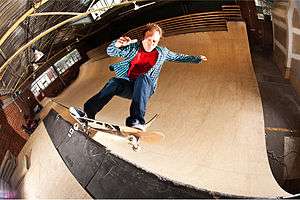Vert skateboarding
Vert skateboarding, short for vertical skateboarding, is the act of riding a skateboard on a skate ramp or other incline and involves the skateboarder transitioning from the horizontal plane to the vertical plane in order to perform skateboarding tricks.[1]

History

Vert skateboarding has its genesis in "pool riding" - the riding of skateboards in an emptied backyard swimming pool - during the 1970s.[2] As riders moved from general street skateboarding and occasional "pool riding" into purpose-built skate parks, vert skateboarding became more popular. Skateboarders began to develop, and then practice, tricks and techniques specifically for vert skateboarding.[3] Vert skateboarding became a common style of skateboarding and was introduced into many competitions and events including the X Games and the Maloof Money Cup.[4] In 2008 ESPN and X Games organisers announced that vert skateboarding would be removed from X Games competitions in favour of free-movement skate-park-style courses where participants would still be able to perform vert skateboarding tricks but would need to do so in combination with other street skateboarding elements.[5] After public condemnation from professional skateboarders Bob Burnquist, Tony Hawk and others, organisers re-instated vert skateboarding.[5] However, in 2011 ESPN announced that the X Games would no longer feature a Women's Vert Skateboarding event, citing a lack of, "a growing participant base, an established annual competition schedule" and, "myriad other factors". Professional skateboarder Lyn-Z Adams Hawkins said the decision would, "end the growth for women's vert skating as we know it".[6] Despite waning support for standalone competition vert skateboarding, vert ramps (often in the form of half-pipes, quarter-pipes or bowls) are present in most modern skateparks.
Skateboard set-up
For vert skateboarding, riders usually set up their boards with 55 mm (or larger) wheels and wider decks for more stability.[2][7]
See also
| Wikimedia Commons has media related to Vert skateboarding. |
- Dropping in
- Vert skating (inline skating technique)
References and sources
- Jeff Savage (2005). Vert Skating: Mastering the Ramp. Capstone. ISBN 978-0-7368-2705-8.
- The Science and Art of Skateboard Design: How Boards Have Changed Over Time (Exploratorium)
- Loveletters To Skateboarding: Style by Blair Alley (Transworld Skateboarding, 31 August 2012) [video]
- Maloof Announces Vert Skaters For South Africa by Blair Alley (Transworld Skateboarding, 20 September 2012)
- X Games Re-Instates Vert Competition After Heat from Pro Skaterboarders + BMX Riders by Ryley Bane (Label Networks, 2008)
- X Games cancels women's Skate Vert by Matt Higginsn(ESPN.com, 31 May 2011)
- Skateboard Guide and Skate Size Chart (Evo.com)